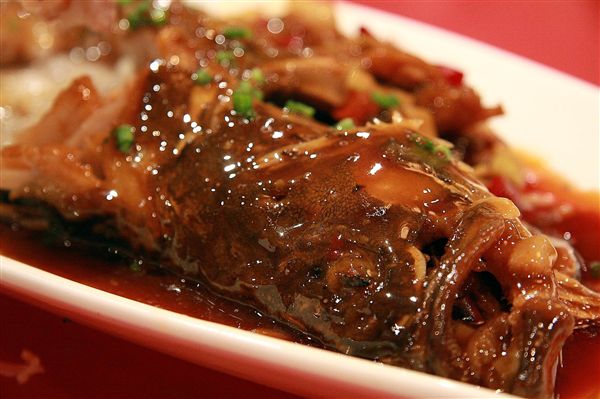Chinese perch is a kind of freshwater fish native to China.
鱖魚是中國獨有的淡水魚之一。
And the thrifty and intelligent Huizhou people invented the magic of cooking the fish through curing or fermenting processes.
儉樸智慧的徽州人則發明了用腌制和發酵這兩種方法來再次制造美味的魔法。
Break up the meat with your chopsticks.
你用筷子把這個魚肉撥開。
The slices of meat look like garlic cloves.
它那個魚肉是呈蒜瓣狀的。
It's very tender and delicious.
一片一片的,很細嫩很鮮美的。

Sliced Salted Pork is another classic dish of Hui Cuisine.
徽菜的另一道代表菜“刀板香”鮮肉腌制后,省略了煙熏的程式。
Cut the salted meat into slices and place them on a camphorwood board without smoking.
切片,把它放在上等的香樟木板上耐心地等待樟木板慢慢吸走咸肉的油膩。
Wait until the board thoroughly drains and grease from the meat.
既保持肉的咸鮮又油而不膩。
Wait until the board thoroughly drains the grease from the meat.
既保持肉的咸鮮又油而不膩。
This way, the pork will taste refreshing.
這才是真正的“刀、板留香”。
Today, in Huangshan Mountain area, you can still see hams and salted meat being hung and sundried in the yards of local households.
在今天的黃山地區農家后院里依然晾曬著火腿和咸肉。
Ye Xinwei Chef Ye thinks his hometown produces the best ham in the world.
葉新偉在葉師傅看來家鄉的農家火腿是世上最美味的火腿。
Of course, he also knows Jinhua in Zhejiang, not far from Huizhou, has a better known ham product famous for nice color, pleasant aroma and fresh taste.
當然他也一定知道在距古徽州不遠的浙江金華有一種更加著名的火腿肌紅脂白,香氣濃郁,滋味鮮美。
Jinhua ham is usually divided into 5 parts.
金華火腿,通常被細分為五個部分。
"Shangfang", literally the upper part, is the best.
“上方”是肉質最好的部位。
It is an indispensable ingredient for making "Braised Ham in Honey Sauce", a traditional dish in Jiangsu and Zhejiang.
江浙傳統名菜“蜜汁火方”中的“火方”指的就是金華火腿的上方。
It will take a cook much energy and time to finish the high-cost dish.
這道菜費工、費料、費時間。
But its sweet, salty taste is truly incomparable.
咸香的火腿澆上事先燒酥的蜜汁咸甜交織,回味無窮。
"Zhongfang", the middle part, can be shredded and cooked with tendons and sea cucumber into a high-end dish served at traditional banquets.
“中方”通常可以切絲與蹄筋、海參搭配成為傳統宴席當中的高檔火腿菜。
The other 3 parts, ham shank, ham claw and ham grease, can be used for cooking soup.
“火瞳”、“火爪”和“滴油”可以用來燉湯。
The broth cooked with Jinhua Ham becomes a basic ingredient of dishes popular in Jiangsu, Zhejiang and Guangdong.
金銀蹄用金華火腿吊出來的湯構成了一切江浙菜乃至傳統粵菜的底味。
Natural conditions influenced the traditional technique of ham making.
火腿的傳統制作工藝受自然條件影響很大。
Mountains surrounding Jinhua city create a perfect natural environment for the production.
金華四面環山為火腿的腌制提供了天造之利。
So someone has suggested the ham develop from the Hui dish "Sliced Salted Pork."
因此有人推論徽菜里的“刀板香”是金華火腿的雛形。
someone has suggested the ham develop from the Hui dish "Sliced Salted Pork."
也有人推論徽菜里的“刀板香”是金華火腿的雛形。
But some legends show that the ham originated 1000 years ago in the Song Dynasty and was originally used to feed the army.
但也有民間傳說認為金華火腿起源于一千年前的宋代曾經是抗擊外族入侵時的一種軍糧。











